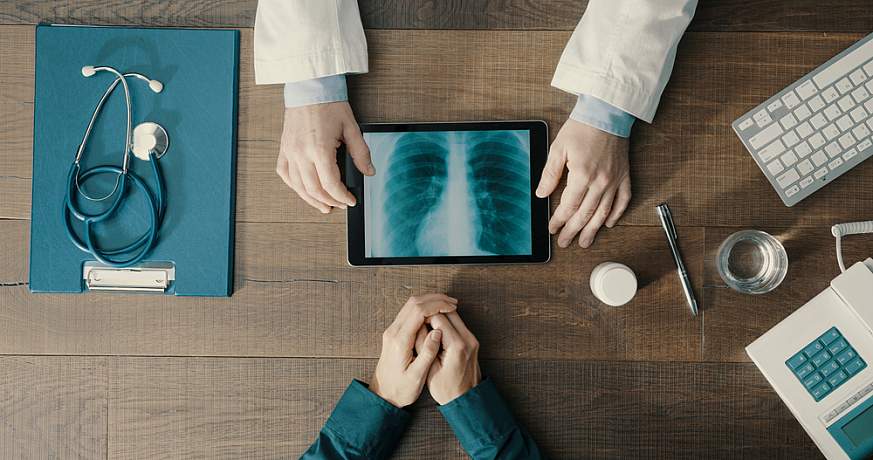You are here
April 27, 2022
Putting Cancer Screening in Perspective

By Paul Pinsky, Ph.D., Chief, Early Detection Research Group, NCI Division of Cancer Prevention; Philip Castle, Ph.D., M.P.H., Director, NCI Division of Cancer Prevention; Maureen Johnson, Ph.D., Executive Secretary, President’s Cancer Panel; and Samantha Finstad, Ph.D., Senior Health Science Policy Advisor, President’s Cancer Panel
It’s common wisdom that “catching the cancer early” is always a good thing. It can be a key factor in being able to survive cancer. You often hear, “luckily, they caught it early,” or the converse, “unfortunately, they didn’t detect it until it had spread” when people talk about friends or relatives with a cancer diagnosis. But the reality of cancer screening is not that simple.
The overall goal of cancer screening is to reduce cancer morbidity (illness) and mortality (death). There is no question that appropriate screening reduces illnesses and deaths due to cancer. Cervical and colorectal cancer incidence has declined in the last few decades by about 55% and 45%, respectively. Death rates have declined even more. These have been due primarily to routine screening.
Some types of screenings can detect cancer early (e.g., mammography for breast cancer and low-dose CT for lung cancer). Others can detect cancer early as well as detect cancer precursors, which can prompt action to prevent the development of cancer (e.g., colonoscopy screening for colorectal cancer and Pap smears and/or HPV testing for cervical cancer). Preventing cancer, even a curable cancer, is a large benefit in itself because it can reduce the many burdens to patients associated with a cancer diagnosis.
But when communicating information about cancer screenings to the public, it’s important to discuss the benefits and the risks. Cancer screening will not necessarily benefit every patient who gets it. A patient could still succumb to cancer despite it being detected early. Others may survive even if their cancer was missed early on and caught at a later stage. And for some patients, screening can actually cause harms.
Screening may lead to the overdiagnosis of indolent (symptomless) cancers. These are cancers detected through screening that would never have become symptomatic in the patient’s lifetime. There is evidence of overdiagnosis associated with various types of screening, most notably PSA screening for prostate cancer. Overdiagnosis of cancer can lead to treatment, or overtreatment, and have serious side effects. For example, impotence and urinary incontinence are associated with prostate cancer surgery.
Screening can also lead to false positives—when people get a positive screening test but no cancer is found. Since screening tests are usually given to healthy people with a low risk of harboring cancer, the tests need to have a high specificity, or the ability to avoid too many false-positive results. A false-positive result can cause anxiety, require additional clinical visits and diagnostic procedures like imaging and biopsies, and lead to high costs for both the medical system and patient. For example, for mammography screening, around 8−12% of women will receive a false positive result at any given screening visit, and up to 45% will receive at least one false positive result over a ten year period of regular screening.
Since cancer screening is intended for those who have no signs or symptoms of cancer, it is important that the benefits strongly outweigh the risks. Cancer screening guidelines can change as new research shows which populations would benefit most from screening with the least harm. For example, more people became eligible for lung cancer screening in 2021, when the U.S. Preventive Services Task Force updated their eligibility recommendations, lowering the minimum age and the amount a person has smoked over their lifetime (or smoking pack-years).
For new screening approaches, establishing the high sensitivity of a test—the ability to find someone who does have cancer—is an important first step in determining its clinical utility. But it is only a first step. Researchers must also demonstrate that the benefits outweigh the harms. Such evidence generally requires a randomized clinical trial in which subjects are randomized to a screening and control arm. The primary outcome is typically mortality from the cancer in question.
There is much discussion lately about the new “multi-cancer early detection” (MCED) tests. Also called liquid biopsies, these are blood tests that can detect multiple different cancer types simultaneously. To date, there has been limited research on the clinical utility of such tests—in other words, if they actually reduce illness and death. As these tests develop, it’s crucial to keep in mind that a sensitive test does not necessarily indicate clinical utility, or that the benefits of MCED screening would outweigh the harms.
While the benefits of appropriate screening are undeniable, it is important to acknowledge that harms can also be associated with screening; more is not always better. When describing cancer screening, make sure to refer to the current guidelines and clarify that screening isn’t for everyone. It should be done only for the right people at the right time.
